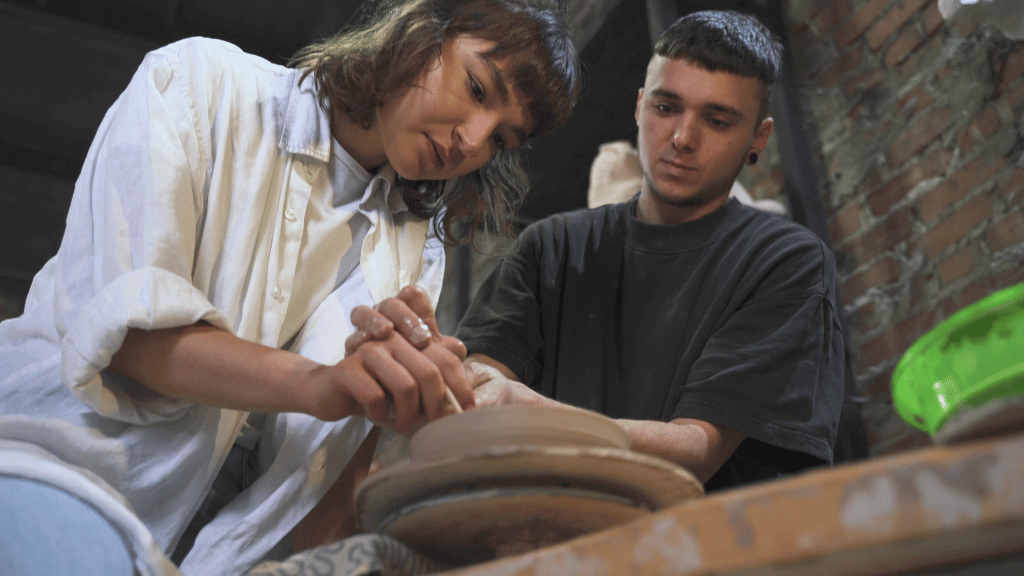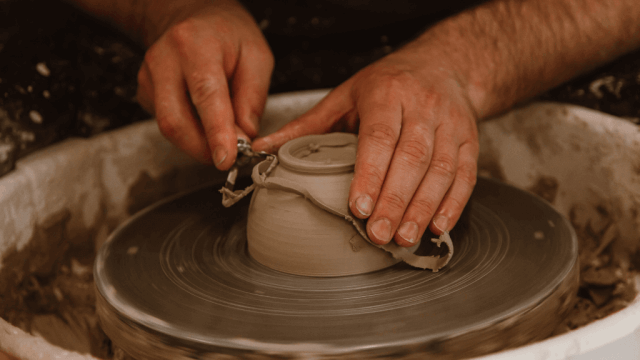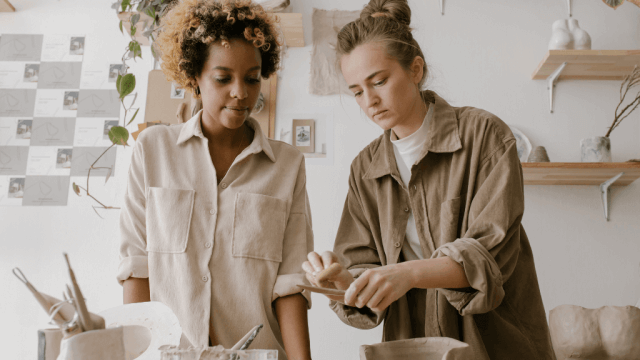Start by acquiring tools and supplies, including clay, a pottery wheel or a shaping implement, kiln or oven-safe containers, glazes, pottery tools, and safety equipment.
Then, follow these steps: preparing the clay, centering it on the wheel (or hand-shaping), forming your pottery piece, allowing it to dry, trimming and refining, bisque-firing, glazing, and firing once more.
Practice, patience, and persistence are vital to improving your pottery skills.
Essential Pottery Tools and Supplies
Before beginning, gather the necessary tools and supplies listed below:
- Clay (stoneware, porcelain, or earthenware)
- Pottery wheel or shaping implement
- Kiln or oven-safe containers
- Glazes
- Pottery tools (wires, ribs, loop, and needle tools)
- Safety equipment (gloves, masks, and aprons)
Preparing the Clay
Begin by kneading the clay using the wedging technique to remove trapped air and achieve a uniform consistency.
This step is vital to prevent flaws and cracks in the final product.
Potters should work on a clean, flat surface, preferably using a canvas sheet.
Centering the Clay on the Wheel
Secure a clay ball to the wheel head for wheel-throwing techniques, ensuring the wheel moves moderately.
Press the clay downwards and inwards using wet hands to center it, allowing for an even distribution of clay.
Alternatively: Hand-Shaping Techniques
For hand-building techniques, create your pottery piece using methods such as coil-building, slab construction, or pinching.
Sculpt and smooth out surfaces with your fingers or tools as required.
Forming Your Pottery Piece
Using the wheel or hand-shaping methods, create the desired shape for your pottery piece while maintaining an even thickness.
For intricate or decorative designs, carving and slip work may be added at this stage.
Allow Drying Time
Allow your pottery piece to dry until it reaches a leather-hard state.
The drying time may vary depending on the size, thickness, and type of clay used.
Dry the pottery piece away from direct sunlight or drafts to prevent cracks during the drying process.
Trimming and Refining
Once leather-hard, trim off excess clay and refine the piece using loop and needle tools.
Smooth out any rough edges and add finishing touches to the design, if desired.
Bisque Firing
After the piece has dried completely, it is ready for bisque firing.
Place your pottery in the kiln or an oven-safe container, following the manufacturer’s guidelines for temperature and firing time.
This firing hardens the pottery, making it less fragile and easier to handle.
Applying Glazes
After bisque firing, choose a suitable glaze for your pottery piece and apply it using a brush or other preferred method.
Glazes are available in various colors and finishes, and multiple coats may be required to achieve the desired result.
Final Firing
Once the glaze has dried, fire your pottery piece again in a kiln or oven-safe container.
This step melts the glaze and binds it to the clay body, resulting in a glassy, protective surface.
The finished pottery piece emerges after this firing.
Choosing the Right Clay
Consider factors such as workability, firing temperature, and final appearance when selecting the type of clay for your pottery project.
Earthenware is the most accessible, low-firing clay and is often used for hand-building techniques.
Stoneware is ideal for both wheel-throwing and hand-building techniques and can be fired at a higher temperature.
Porcelain, recognized for its unique translucency, presents more of a challenge due to its finicky nature but yields a beautiful result when mastered.
Setting Up Your Home Pottery Studio
Create a dedicated workspace for your pottery endeavors.
Ensure the area has ample lighting, ventilation, and organization.
Sturdy tables, shelves, and storage solutions are crucial in creating an efficient flow during the pottery-making process.
Set up your pottery wheel or workspace, tools, and kiln according to your specific needs and the available space in your home.
Pottery-Wheel Techniques
When using a pottery wheel, understanding and mastering basic techniques can lead to better outcomes.
Here are common techniques to practice:
- Opening – Create a hollow center in the centered clay by pressing down with your fingers.
- Pulling – To increase the height of the walls, gently move your fingers upwards, maintaining steady pressure and even thickness.
- Collaring – Taper the clay’s top edge inward by applying gentle, even pressure to the spinning rim.
- Shaping – Employ your fingertips, knuckles, and a variety of forming tools to create nuanced contours and shapes.
Caring for Your Tools and Equipment
Proper maintenance of your pottery tools and equipment can extend their lifespan and efficiency.
Clean your tools, pottery wheel, and workspace after each session.
When not in use, store tools and materials in a dry and protected environment.
Refer to manufacturer guidelines for maintaining kilns and addressing any potential issues.
Staying Safe and Clean
Pottery-making can be messy and potentially hazardous.
Be sure to wear appropriate protective gear such as aprons, gloves, and masks to minimize risks.
Keep buckets of water and sponges handy for quick cleaning and to maintain the moisture level of your clay.
Develop a cleanup routine to keep your workspace sanitary and free from debris.
Join the Pottery Community
Connecting with fellow potters can provide a wealth of knowledge, support, and inspiration.
Engage in online forums, social media groups, and local classes or workshops to share experiences, learn new techniques, and continuously improve your pottery-making skills.
Frequently Asked Questions
We understand that making pottery at home can raise several questions for beginners and experienced potters alike.
Below, we’ve compiled answers to some of the most common inquiries related to the subject matter of this blog post.
Can I use my regular kitchen oven for firing pottery?
Unfortunately, a standard kitchen oven is unsuitable for firing pottery as it cannot reach the required high temperatures.
A specialized kiln, capable of achieving significantly higher temperatures, is necessary for the pottery firing process.
How long does it take for pottery to dry?
The drying time for pottery pieces depends on factors such as climate, thickness, size, and type of clay used.
Smaller, thinner items may dry within a few days, while larger, thicker pieces can take several weeks.
Always ensure your pottery piece is entirely dry before firing to avoid cracks or damage.
How can I prevent cracks in my pottery?
To minimize the risk of cracks, follow these steps: wedge the clay thoroughly to remove bubbles and ensure consistent texture, maintain even thickness throughout the piece, dry it slowly and evenly away from direct sunlight, and ensure that the pottery is completely dry before firing.
What types of pottery glaze finishes are available?
Pottery glazes come in a variety of finishes to suit your preferences and vision, such as glossy, matte, and satin.
Additionally, glazes are available in numerous colors, from natural earth tones to vibrant, jewel-like hues.
Experimenting with combinations and layering techniques can yield unique results.
How can I dispose of used clay water and clay scraps?
Used clay water should never be poured down drains as it can cause blockages.
Instead, allow the clay particles to settle, separate them from the water, and dispose of them with solid waste.
Recycle unfired clay scraps by rehydrating them, processing them with a pug mill, or wedging them back into usable clay.











